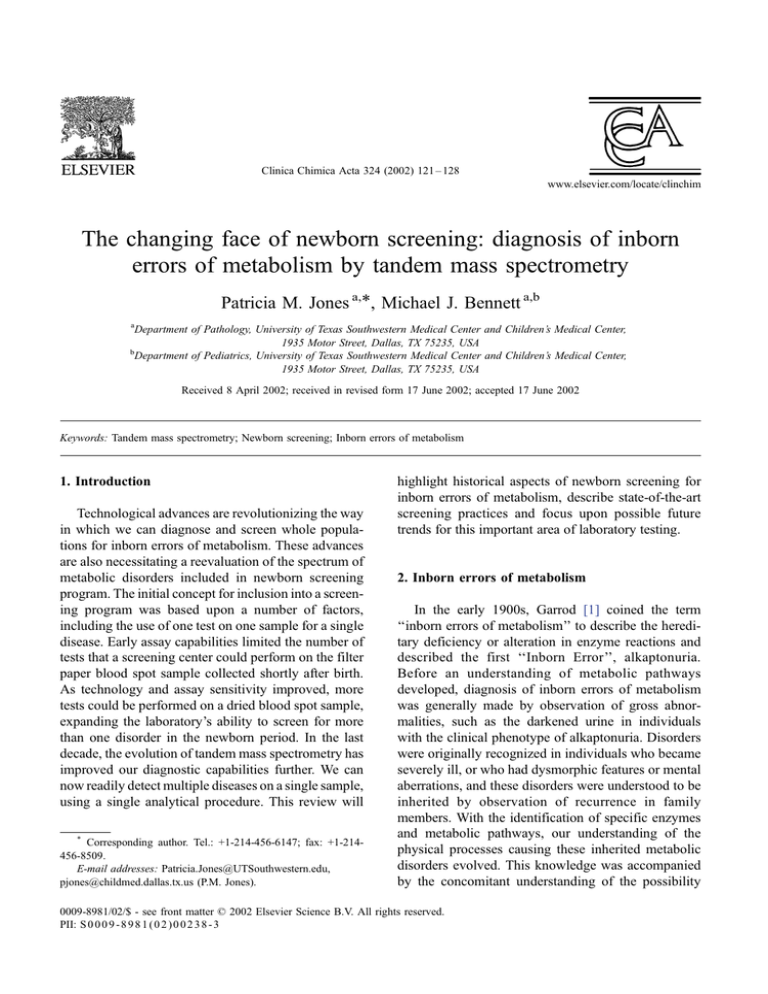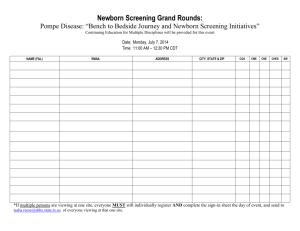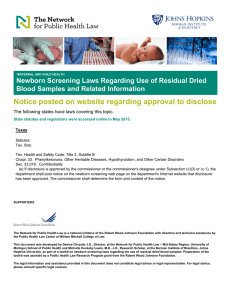
Clinica Chimica Acta 324 (2002) 121 – 128
www.elsevier.com/locate/clinchim
The changing face of newborn screening: diagnosis of inborn
errors of metabolism by tandem mass spectrometry
Patricia M. Jones a,*, Michael J. Bennett a,b
a
Department of Pathology, University of Texas Southwestern Medical Center and Children’s Medical Center,
1935 Motor Street, Dallas, TX 75235, USA
b
Department of Pediatrics, University of Texas Southwestern Medical Center and Children’s Medical Center,
1935 Motor Street, Dallas, TX 75235, USA
Received 8 April 2002; received in revised form 17 June 2002; accepted 17 June 2002
Keywords: Tandem mass spectrometry; Newborn screening; Inborn errors of metabolism
1. Introduction
Technological advances are revolutionizing the way
in which we can diagnose and screen whole populations for inborn errors of metabolism. These advances
are also necessitating a reevaluation of the spectrum of
metabolic disorders included in newborn screening
program. The initial concept for inclusion into a screening program was based upon a number of factors,
including the use of one test on one sample for a single
disease. Early assay capabilities limited the number of
tests that a screening center could perform on the filter
paper blood spot sample collected shortly after birth.
As technology and assay sensitivity improved, more
tests could be performed on a dried blood spot sample,
expanding the laboratory’s ability to screen for more
than one disorder in the newborn period. In the last
decade, the evolution of tandem mass spectrometry has
improved our diagnostic capabilities further. We can
now readily detect multiple diseases on a single sample,
using a single analytical procedure. This review will
*
Corresponding author. Tel.: +1-214-456-6147; fax: +1-214456-8509.
E-mail addresses: Patricia.Jones@UTSouthwestern.edu,
pjones@childmed.dallas.tx.us (P.M. Jones).
highlight historical aspects of newborn screening for
inborn errors of metabolism, describe state-of-the-art
screening practices and focus upon possible future
trends for this important area of laboratory testing.
2. Inborn errors of metabolism
In the early 1900s, Garrod [1] coined the term
‘‘inborn errors of metabolism’’ to describe the hereditary deficiency or alteration in enzyme reactions and
described the first ‘‘Inborn Error’’, alkaptonuria.
Before an understanding of metabolic pathways
developed, diagnosis of inborn errors of metabolism
was generally made by observation of gross abnormalities, such as the darkened urine in individuals
with the clinical phenotype of alkaptonuria. Disorders
were originally recognized in individuals who became
severely ill, or who had dysmorphic features or mental
aberrations, and these disorders were understood to be
inherited by observation of recurrence in family
members. With the identification of specific enzymes
and metabolic pathways, our understanding of the
physical processes causing these inherited metabolic
disorders evolved. This knowledge was accompanied
by the concomitant understanding of the possibility
0009-8981/02/$ - see front matter D 2002 Elsevier Science B.V. All rights reserved.
PII: S 0 0 0 9 - 8 9 8 1 ( 0 2 ) 0 0 2 3 8 - 3
122
P.M. Jones, M.J. Bennett / Clinica Chimica Acta 324 (2002) 121–128
for errors at various stages in those pathways. It was
recognized that deficient enzymes could be identified
in individuals by analysis of body fluids and measuring the accumulation of substrate for that enzyme, or
the accumulation of unusual products of pathways
utilized in response to the enzymatic block.
At almost the same time as Garrod’s seminal
observation, the basis of current concepts of genetic
theory was being elucidated. Beadle and Tatum were
instrumental in formalizing the concept of one gene –
one enzyme. In this theory, an indivisible unit of
heredity called a gene was thought to be responsible
for the presence and activity of a single enzyme or
protein [2,3]. The diagnostic search began for the
altered or missing genes that produced the deficient
enzymes, and an inborn error of metabolism was
believed to be an ‘‘all-or-none’’ affair. Early on, only
severe forms of inborn errors were diagnosed and it is
only recently that we have come to understand that
there is a continuum of mild to severe forms for almost
every genetic defect known to date. Frequently, the
first literature cases for inborn errors were those
presenting with the severe phenotype, as these patients
were easier to recognize in the population. Because the
initial descriptions tend to define the phenotype for
future patient investigations, milder variants often
went undiagnosed.
The current state of knowledge allows the diagnosis
of many inborn errors of metabolism by detection of
the aberrant gene. However, as multiple genetic
defects may result in the same biochemical phenotype,
most diagnoses of genetic defects in a clinical setting
are still accomplished by finding an abnormal accumulation of metabolites of the affected pathways, or
unusual metabolites from alternate pathways. The
advances made in the diagnosis of inborn errors of
metabolism in recent years have not only been in the
field of discovering new genes, but in technological
advances in our ability to detect intermediates of
metabolism in smaller samples, with greater efficiency
and with fewer tests.
3. Newborn screening
In the early 1960s, Guthrie developed the first
method applicable to whole population screening for
phenylketonuria (PKU). In this assay, he measured
phenylalanine in blood spots on filter paper using a
bacterial inhibition assay [4,5]. In 1962, the state of
Massachusetts instituted the first newborn screening
program for PKU. At that point, it was already recognized that early detection of PKU and early introduction of a diet low in phenylalanine resulted in a
significant decrease in morbidity, as well as significant
savings of medical costs.
Ideally, detection of genetic disorders should occur
very early in life, in a presymptomatic, well individual, before the metabolic error could disrupt mental or
physical health and growth. The criteria for inclusion
of a test/disorder into a newborn screening program
continue to evolve. Currently the disorders included in
most newborn screening programs essentially meet
the following criteria:
1. have a significant incidence in the population
screened,
2. are clinically well defined with the untreated
natural history characterized,
3. have a well-defined biochemical phenotype,
4. cause significant morbidity and/or mortality,
5. are treatable, where treatment improves outcome,
6. testing is safe, simple and sufficiently sensitive.
7. specific confirmatory testing is available
8. testing, treatment and treatment outcome are cost
effective with respect to non-treatment.
PKU serves as an excellent example of a metabolic
disorder that fulfills these criteria [6]. The incidence at
about 1 in 14,000 is sufficiently high to make PKU a
significant public health issue. The biochemical phenotype is well defined, as is the untreated natural
history in which patients follow a severe neurodegenerative course. When a patient with PKU is treated,
the outcome is essentially that of a normal individual.
Testing procedures are clearly cost effective. Currently, the cost of maintaining an individual with
untreated PKU at an appropriate care facility is on
the order of US$80,000/year. Fees charged for newborn screening range from US$15 to US$40 per
sample screened, depending on the State and the level
of screening offered. The actual cost to run just the
PKU screen is probably in the neighborhood of US$4
per sample. Add to that the cost of follow up of
individuals with positive screens and the cost of a low
phenylalanine diet ( f US$6500/year for formula and
P.M. Jones, M.J. Bennett / Clinica Chimica Acta 324 (2002) 121–128
low protein diet), and the resulting figures are still
impressively less than US$80,000/year.
By way of contrast with PKU, examples of disorders
included in newborn screening programs that do not
readily fit this list of criteria can be found easily. Table 1
gives the list of disorders that are screened for in the
USA [7,8]. Of these disorders, Maple Syrup Urine
Disease (MSUD) has a frequency in the general population of around 1 in 185,000, and galactosemia has an
incidence of approximately 1 in 44,000 to 1 in 80,000.
In the case of galactosemia, early treatment has not
necessarily improved long-term outcome. Both of
these diseases often present as a clinical crisis in the
newborn period before the results of newborn screening tests are returned. Such disorders still require
clinical diagnosis during the acute crisis in many
instances. At present, newborn screening for galactosemia is performed in 48 of 50 states. Cystic fibrosis,
with an incidence of approximately 1 in 2500, is
presently screened for in only four states, with pilot
programs in three more. Testing for the most common
DNA mutation for this disorder only includes approximately 75% of affected individuals, causing this test to
be considered insufficiently sensitive for inclusion in a
Table 1
Disorders currently included in newborn screening programs in the
US
Disorder
Approximate incidence
Number of
states screening
PKU
Congenital
hypothyroidism
Galactosemia
Sickle cell disease
Congenital adrenal
hyperplasia
Biotinidase deficiency
Maple syrup
urine disease
Homocystinuria
MCAD
Cystic fibrosis
Tyrosinemia
Glucose-6-phosphate
dehyd.
1:14,000
1:4000
50
50
1:44,000 – 80,000a
1:40,000a
1:10,000 – 18,000
48
47
26
1:60,000
1:185,000b
25
25
1:200,000
1:14,000
1:2500
1:100,000 – 120,000c
1:34 – 200d
16
8
7
2
1
a
Depending on population.
1:176 in Amish/Mennonite populations in Pennsylvania.
c
1:1846 in parts of Quebec, Canada.
d
Incidence in males in the US. Incidence is 1:4 – 10 in parts of
Africa and Asia.
b
123
general screening program. Medium-chain acyl-CoA
dehydrogenase (MCAD) deficiency is just beginning
to be included on newborn screens in some testing
centers (seven states and one trial), and yet it has a
relatively high incidence (approximately 1 in 14,000),
has a significant mortality (25%) upon first presentation and is eminently treatable. Currently, we are
undergoing a paradigm shift in choosing suitable
criteria for disease inclusion in newborn screening
programs, as new technologies make it possible to
easily test for more disorders without additional cost.
The leading technology driving these changes is the
introduction of the tandem mass spectrometric methods
for metabolite analysis.
4. Tandem mass spectrometry
Mass spectrometry (MS) is an ideal tool for the
identification of metabolites. The very specific mass
fragmentation patterns provide ‘‘chemical fingerprints’’, and the only true positive identification mechanism for chemical compounds and metabolic intermediates. Chromatographic techniques are ideal for
separation of compounds out of a complex mixture in
a biological matrix, i.e. serum, but in the absence of
MS, these techniques have always suffered from the
problem of basing compound identification on retention time. Positive identification can never be made in a
system where an unknown can co-elute at a known
retention time. Thus, when mass spectrometry was
introduced, coupled to gas chromatography with its
high-efficiency separations, an ideal balance was
achieved. Positive identification of compounds could
now be made, based on very specific mass spectra, or
ion fragment patterns. The drawbacks to this technique
often involved the inability to make a compound
volatile enough to separate it by gas chromatography.
In addition, the long separation times, up to 65 min per
sample for a urine organic acid analysis, make this
analytical approach unsuitable for whole population
screening. In recent years, mass spectrometers have
been linked to liquid chromatographic systems. Liquid
chromatography separates the compounds and mass
spectrometry serves as the detector.
Tandem mass spectrometry builds on these simple
principles. Tandem MS, or MS/MS involves two mass
spectrometers in sequence. This arrangement allows
124
P.M. Jones, M.J. Bennett / Clinica Chimica Acta 324 (2002) 121–128
the instrument to scan for either a precursor ion mass,
a product ion mass after fragmentation of the compound, or a combination of the two. An excellent
review of mass spectrometry methods has previously
been written [9].
Tandem MS instruments have the capability of
being used with a direct injection, when no separation
is necessary, or being linked to a liquid chromatography system if some separation is required. In either
case, run times for a tandem MS instrument are often
Table 2
Some disorders that can be screened for by tandem MS
Class
Disorder
Estimated incidence
Treatment
improves
outcome
Amino acids
Homocystinuria
Hypermethioninemia (1:20,000 in Denmark)
MSUD
PKU
Tyrosinemia, type 1 and 2
GA1
GA2
HMG CoA lyase deficiency
Isovaleric acidemia
MCC deficiency
MMAd
PA
3-ketothiolase deficiency
Argininemia
ASA
Citrullinemia
CPT 1 deficiency
CPT 2 deficiency
C/AT defect
LCHAD/TFP deficiency
MCAD deficiency
SCAD deficiency
VLCAD deficiency
Peroxisomal disorders
Lysosomal disorders
Purine/pyrimidine disorders
Steroid disordersi
Bile acid disorders
1:200,000
1:335,000
1:185,000
1:14,000
1:100,000 – 120,000
1:50,000
not establisheda
> 100 casesc
>70 cases
>50 casesc
1:48,000 – 61,000
1:87,000 – 137,000e
>50 cases
1:363,000
1:70,000
1:57,000
f 20 casesf
>200 casesf
f 10 casesf
>200 casesf,g
1:14,000
not establishedc
>200 casesf
1:50,000
1:8000 – 200,000h
not established
1:10,000 – 18,000
not established
yes
yes
yes
yes
yes
yes
+/
+/
yes
+/
yes
yes
yes
+/
yes
+/
yes
+/
+/
+/
yes
+/
+/
+/
?
?
yes
?
Organic acids
Urea cycle
Fatty acids
Other
b
b
b
b
b
b
b
b
b
b
b
ASA = Argininosuccinic aciduria, CPT = carnitine palmitoyltransferase, C/AT = carnitine/acylcarnitine translocase, GA1, GA2 = glutaric
acidemia, type 1 and type 2, HMG = 3-hydroxy-3-methylglutaryl, LCHAD = long-chain L-3-hydroxyacyl CoA dehydrogenase, MCC = 3methylcrotonyl CoA carboxylase, MMA = methylmalonic acidemia, MSUD = maple syrup urine disease, PA = propionic acidemia,
SCAD = short-chain acyl-CoA dehydrogenase, TFP = trifunctional protein, VLCAD = very-long-chain acyl-CoA dehydrogenase.
a
Incidence unknown, but not rare. May be as common as GA1.
b
Outcome depends on age of onset and severity.
c
Greater than expected numbers being identified in tandem MS screening programs.
d
Not all cases of MMA are detected by tandem MS screening, including false negatives in detecting the cobalamin defects.
e
Refs. [31 – 33].
f
Authors’ personal experience.
g
Less than expected numbers being identified in tandem MS screening programs.
h
Estimated incidence of all lysosomal disorders is f 1:8000; specifically for Pompe’s disease which is detectable by tandem MS,
incidence is f 1:200,000 [52,53].
i
Specifically 21-hydroxylase deficiency.
P.M. Jones, M.J. Bennett / Clinica Chimica Acta 324 (2002) 121–128
significantly shorter than HPLC or GC/MS run times.
For comparison purposes, a normal GC/MS run for
organic acids takes about 1 h. An ion-selective
chromatographic method for amino acids can take
anywhere from 30 min for a single phenylalanine
measurement to 135 min for a screen for multiple
amino acids. A phenylalanine assay by tandem MS
takes less than 2 min. The rapidity of this assay is not
its only positive asset in terms of newborn screening.
The addition of tyrosine and use of a phenylalanine/
tyrosine ratio has been shown to result in significantly
fewer false positives, enhancing the utility of the
assay [10]. Tandem MS is a very specific, very
sensitive technology that has been utilized to detect
a wide variety of analytes and diseases [11 – 21].
Table 2 shows some of the disorders that can currently be screened for by tandem mass spectrometry.
In Table 2, the columns showing estimated incidence
and treatment outcome are derived from the individual chapters for each disorder in The Metabolic and
Molecular Bases of Inherited Disease, 8th ed.,
Charles R. Scriver, et al., editors [22], unless otherwise specified in the table. Using tandem MS, a single
blood test is now capable of detecting more than 20
inborn errors of metabolism [23,24]. The technology
and methodology are currently being scrutinized and
recommendations made for utilization and standardization [25 – 29].
The disadvantages of MS/MS are those found with
any new technology. The initial cost of a system is high.
A level of expertise is needed for preparing samples
and operating the system. And a level of expertise is
required to interpret the data produced by the MS/MS.
Many of the metabolic intermediates detected by this
methodology are elevated in multiple different disorders, and so proficiency in interpretation is necessary.
As with any screening test, follow-up testing for diagnosis is mandatory.
5. Results of ongoing screening programs
Table 3 summarizes the findings from five newborn screening programs that utilize tandem MS
technology [30 – 34]. The studies presented ranged
from 7 months to 7 years in length and 1100 to
>700,000 patient samples tested. The studies clearly
demonstrate the multiple utilities of this methodol-
125
Table 3
Results of ongoing screening programs using tandem MS
Program
Duration
Number
screened
Disorders found
New South Wales,
Australia
1 year
137,000
New England, USA
2 years
257,000
164,000
Neo Gen Screening
7 years
>700,000
Bavaria, Germany
7 months
87,000
Ankara, Turkey
1 year
1160
23 amino acid
3 fatty acid
5 organic acid
22 amino acid
17 fatty acid
3 organic acid
86 amino acids
45 fatty acid
32 organic acids
10 amino acids
8 fatty acids
4 organic acids
6 amino acids
4 organic acids
ogy. Not only are inborn errors of metabolism being
diagnosed in a timely manner which allows for rapid
treatment, tandem MS is also assisting in determining
population incidence of various metabolic disorders,
and diagnosing disorders that were previously being
missed. In the large studies, the incidence of MCAD
detected is between 1:14,000 and 1:20,000, except in
Australia where it is 1:68,000. Prior to screening by
tandem MS, 3-methylcrotonyl CoA carboxylase
(MCC) deficiency was believed to be very rare, with
only a few cases reported. However, in three of the
large studies, MCC deficiency was diagnosed at
incidences of 1:29,000 to 1:257,000, depending on
the population [31 – 33]. The approximate incidences
of the major types of disorders detected (amino acid,
organic acid, etc.) are similar among studies, with the
exception of the small study performed in Turkey.
The Turkish study illustrates the much higher incidence rates that can be found with a small sample
size and a specific population. Of interest in the large
studies is the fact that the average overall incidence
of a detectable inborn error of metabolism occurring
is approximately 1 in every 4600 live births (New
South Wales—1:4419; New England—1:5840; Neo
Gen—1:4399; Bavaria—1:3954). As can be seen in
Table 2, the clinical outcomes for the majority of
these disorders are improved by treatment if diagnosis is made early and treatment is started quickly
enough.
126
P.M. Jones, M.J. Bennett / Clinica Chimica Acta 324 (2002) 121–128
6. Future directions
With the advent of new technologies and the
elucidation of new inborn errors of metabolism, the
criteria for inclusion of a specific test or disease in a
newborn screen are constantly being reconsidered
[35]. An increasing number of reports in the recent
literature are employing tandem MS to screen for and
to diagnosis many different types of inborn errors of
metabolism, including congenital disorders of glycosylation, disorders of purine and pyrimidine metabolism, adrenal cortical insufficiency, and galactosemia
[36 – 39]. Tandem MS is being utilized for diagnosing
disorders of fatty acid oxidation and related pathways,
such as carnitine palmitoyltransferase II deficiency,
very long chain acyl-CoA dehydrogenase deficiency
and mitochondrial trifunctional protein deficiency
[40 – 42]. New disorders are also being discovered
with this technology [43,44]. Milder variants of diseases whose diagnosis may have been missed using
older technologies are being recognized by newborn
screening with tandem MS. A previously unrecognized genotype for MCAD deficiency has been identified by the ongoing screening programs [45,46].
Tandem mass spectrometry analysis of bile acids
may be a useful diagnostic aid for other disorders,
including peroxisomal disorders [47] and cholestatic
hepatobiliary disease [48]. Cases such as the above
suggest that tandem mass spectrometry may cause
rapid expansion of the newborn screening programs,
and cause us to rethink our criteria for newborn
screening.
Simple tests are becoming available for rapid
diagnosis of inborn errors of metabolism which have
no known treatment that improves outcome, or are
extremely rare. Both of these characteristics would
have excluded these disorders from newborn screening in the past. Diagnosing these disorders whenever
possible, however, can have an important effect on
such areas as genetic counseling and new treatment
possibilities. The question arises as to whether a test
for an extremely rare disease should be routinely done
simply because the test is easy to perform, inexpensive and available. When treatment could significantly
alter outcome, there is very little debate over whether
a disorder should be included in a newborn screen,
unless the test is not specific enough or extremely
costly. At some point this debate leaves cost consid-
erations and becomes ethical. With the current ability
of tandem MS to pick up elevated concentrations of
metabolites and unusual metabolites, new and presently untreatable disorders will be detected, and the
question becomes whether to report them. Although
the controversy will continue over whether diagnosis
of certain disorders should be done simply because it
can be done, in the long run lack of knowledge may
turn out to be more harmful than knowledge.
7. Summary
Newborn screening for inborn errors of metabolism
is a field that is undergoing a revolution in all of its
aspects [49,50]. Technological advances are driving
our ability to assay for more disorders with little
increase in time, resources or cost. The computer
age is also a driving force in this field, as the general
public becomes aware of new testing capabilities
through magazines and Internet information flow
and places its own demands on test menu and accessibility [51]. These rapid changes and increases in
capabilities are in turn driving an evolving focus as to
which disorders should be screened. Along with these
alterations comes the responsibility to manage the
changes appropriately. There is a growing need for
standardization of all phases of the newborn screening
program, including test menu and methodology, cutoff values, reporting of results and follow-up of
positive results.
With the advances occurring in tandem mass
spectrometric methodology, we predict that essentially
all newborn screening for inborn errors will be done
by this method within the next 10 years. Clinical
laboratories performing this testing will need to be
capable of and responsible for all aspects of the
programs.
References
[1] Garrod AE. The incidence of alkaptonuria: a study in chemical
individuality. Lancet Dec 1902;13:1616 – 20.
[2] Stent GS, Calendar R. The one gene – one enzyme theory.
Molecular genetics: an introductory narrative, 2nd ed. San
Francisco, CA: Freeman; 1978. p. 131 – 6.
[3] Beadle GW, Tatum EL. Genetic control of biochemical reactions in Neurospora. PNAS 1941;27:499 – 506.
P.M. Jones, M.J. Bennett / Clinica Chimica Acta 324 (2002) 121–128
[4] Guthrie R, Susi A. A simple phenylalanine method for detecting phenylketonuria in large populations of newborn infants.
Pediatrics 1963;32:338 – 43.
[5] Guthrie R. The origin of newborn screening. Screening 1992;
1:5 – 15.
[6] National Institutes of Health. Phenylketonuria (PKU): screening and management. NIH Consens Statement 2000;17(3):
1 – 33.
[7] American Academy of Pediatrics Newborn Screening Task
Force. Serving the family from birth to the medical home.
Newborn screening: a blueprint for the future. A call for a
national agenda on state newborn screening programs. Pediatrics 2000;106:389 – 427 (Suppl).
[8] US National Screening Status Report. National Newborn
Screening and Genetics Resource Center, September, 2001.
http://genes-r-us.uthscsa.edu (accessed February 7, 2002).
[9] Chace DH. Mass spectrometry in the clinical laboratory. Chem
Rev 2001;101:445 – 77.
[10] Chace DH, Sherwin JE, Hillman SL, Lorey F, Cunningham
GC. Use of phenylalanine-to-tyrosine ratio determined by tandem mass spectrometry to improve newborn screening for
phenylketonuria of early discharge specimens collected in
the first 24 hours. Clin Chem 1998;44:2405 – 9.
[11] Chace DH, Hillman SL, Millington DS, Khaler SG, Roe CR,
Naylor EW. Rapid diagnosis of maple syrup urine disease in
blood spots from newborns by tandem mass spectrometry. Clin
Chem 1995;41:62 – 8.
[12] Chace DH, Hillman SL, Millington DS, Kahler SG, Adam
BW, Levy HL. Rapid diagnosis of homocystinuria and other
hypermethioninemias from newborns’ blood spots by tandem
mass spectrometry. Clin Chem 1996;42:349 – 55.
[13] Chace DH, Hillman SL, Van Hove JLK, Naylor EW. Rapid
diagnosis of MCAD deficiency: quantitative analysis of octanoylcarnitine and other acylcanitines in newborn blood spots
by tandem mass spectrometry. Clin Chem 1997;43:2106 – 13.
[14] Vreken P, van Lint ABM, Bootsma AH, Overmars H, Wanders
RJA, van Gennip AH. Quantitative plasma acylcarnitine analysis using electrospray tandem mass spectrometry for the diagnosis of organic acidaemias and fatty acid oxidation defects.
J Inherit Metab Dis 1999;22:302 – 6.
[15] Smith WE, Millington DS, Kishnani PS, McDonald M, Koeberl DD. Evaluation of elevated hydroxyisovalerylcarnitine
(C5-OH) in the newborn screen by tandem mass spectrometry.
J Inherit Metab Dis 2000;23(Suppl 1):14.
[16] Whitfield PD, Sharp P, Johnson D, Taylor R, Fletcher J,
Hopwood JJ, et al. Rapid diagnosis of lysosomal storage
disorders by tandem mass spectrometry. J Inherit Metab Dis
2000;23(Suppl 1):19.
[17] Magera MJ, Helgeson JK, Matern D, Rinaldo P. Methylmalonic acid measured in plasma and urine by stable-isotope
dilution and electrospray tandem mass spectrometry. Clin
Chem 2000;46(11):1804 – 10.
[18] Kushnir MM, Komaromy-Hiller G, Shushan B, Urry FM,
Roberts WL. Analysis of dicarboxylic acids by tandem mass
spectrometry. High-throughput quantitative measurement of
methylmalonic acid in serum, plasma, and urine. Clin Chem
2001;47(11):1993 – 2002.
127
[19] Chace DH, DiPerna JC, Kalas TA, Johnson RW, Naylor EW.
Rapid diagnosis of methylmalonic and propionic acidemias:
quantitative tandem mass spectrometric analysis of propionylcarnitine in filter-paper blood specimens obtained from newborns. Clin Chem 2001;47(11):2040 – 4.
[20] Magera MJ, Stoor AL, Helgeson JK, Matern D, Rinaldo P.
Determination of homovanillic acid in urine by stable isotope
dilution and electrospray tandem mass spectrometry. CCA
2001;306(1 – 2):35 – 41.
[21] Roe CR, Roe DS. Detection of gene defects in branched-chain
amino acid metabolism by tandem mass spectrometry of carnitine esters produced by cultured fibroblasts. Methods Enzymol 2000;324:424 – 31.
[22] Scriver CR, Beaudet AL, Sly WS, Valle D, Childs B, Kinzler
KW, et al. The metabolic and molecular bases of inherited
disease, 8th ed. New York: McGraw-Hill, 2001. p. 1 – 6338.
[23] Rashed MS, Ozand PT, Bucknall MP, Little D. Diagnosis of
inborn errors of metabolism from blood spots by acylcarnitines
and amino acid profiling using automated electrospray tandem
mass spectrometry. Pediatr Res 1995;38:324 – 31.
[24] Johnson AW, Mills K, Clayton PT. Use of automated electrospray ionization tandem MS for the diagnosis of inborn errors
of metabolism from dried blood spots. Biochem Soc Trans
1996;24:932 – 8.
[25] Pollitt RJ. Tandem mass spectrometry screening: proving effectiveness. Acta Paediatr, Suppl 1999;432:40 – 4.
[26] Hardy DT. Technological developments: development of tandem mass spectrometry for neonatal screening. The Birmingham Children’s Hospital, NHS Trust July 1999;432:1 – 81.
[27] Sweetman L. Newborn screening by tandem mass spectrometry: gaining experience. Clin Chem 2001;47(11):1937 – 8.
[28] Seymour CA, Thomason MJ, Chalmers RA, Addison GM,
Bain MD, Cockburn F, et al. Neonatal screening for inborn
errors of metabolism: a systematic review. Health Technol
Assess 1997;1(11):1 – 5 (Executive summary).
[29] Charrow J, et al, for the American College of Medical Genetics/American Society of Human Genetics Test and Technology
Transfer Committee Working Group. Tandem mass spectrometry in newborn screening. Genet Med 2000;2(4):267 – 9.
[30] Wley V, Carpenter K, Wilcken B. Newborn screening with
tandem mass spectrometry: 12 months’ experience in NSW
Australia. Acta Paediatr, Suppl 1999;88:48 – 51.
[31] Zytkovicz TH, Fitzgerald EF, Marsden D, Larson CA, Shih
VE, Johnson DM, et al. Tandem mass spectrometric analysis
for amino, organic, and fatty acid disorders in newborn dried
blood spots: a two-year summary from the new England newborn screening program. Clin Chem 2001;47(11):1945 – 55.
[32] Naylor EW, Chace DH. Automated tandem mass spectrometry for mass newborn screening for disorders in fatty acid,
organic acid and amino acid metabolism. J Child Neurol
1999;14(Suppl 1):S4 – 8.
[33] Liebl B, Fingerhut R, Roschinger W, Muntau A, Knerr I,
Olgemoller B, et al. Model project for updating neonatal
screening in Bavaria: concept and initial results. [German]
Gesundheitswesen 2000;62(4):189 – 95.
[34] Biberoglu G, Hasanoglu A, Tumer L, Ezgu FS, Genc B.
Screening inborn errors of metabolism from dried blood spots
128
[35]
[36]
[37]
[38]
[39]
[40]
[41]
[42]
[43]
P.M. Jones, M.J. Bennett / Clinica Chimica Acta 324 (2002) 121–128
using electrospray tandem mass spectrometry. J Inherit Metab
Dis 2001;24(Suppl 1):4.
US Department of Health and Human Services. Using tandem
mass spectrometry for metabolic disease screening among
newborns. A report of a work group. Morbidity and Mortality
Weekly Report, Recommendations and Reports. 50(RR-3)
(2001) 2 – 34.
Lacey JM, Bergen HR, Magera MJ, Naylor S, O’Brien JF.
Rapid determination of transferrin isoforms by immunoaffinity
liquid chromatography and electrospray mass spectrometry.
Clin Chem 2001;47(3):513 – 8.
Goggerle M, Wallner S, Korall H. Rapid screening method in
urine for disorders of purine and pyrimidine metabolism using
isocratic reversed-phase HPLC-MS/MS. J Inherit Metab Dis
2001;24(Suppl 1):9.
Kao PC, Machacek DA, Magera MJ, Lacey JM, Rinaldo P.
Diagnosis of adrenal cortical insufficiency by liquid chromatography-tandem mass spectrometry. Ann Clin Lab Sci 2001;
31:199 – 204.
Jensen UG, Brandt NJ, Christensen E, Skovby F, NorgaardPedersen B, Simonsen H. Neonatal screening for galactosemia
by quantitative analysis of hexose monophosphates using tandem mass spectrometry: a retrospective study. Clin Chem
2001;47(8):1364 – 72.
Albers S, Marsden D, Quackenbush E, Stark AR, Levy HL,
Irons M. Detection of neonatal carnitine palmitoyltransferase
II deficiency by expanded newborn screening with tandem
mass spectrometry. Pediatrics 2001;107(6):e103.
Wood JC, Magera MJ, Rinaldo P, Seashore MR, Strauss AW,
Friedman A. Diagnosis of very long chain acyl-dehydrogenase
deficiency from an infant’s newborn screening card. Pediatrics
2001;108(1):e19.
Matern D, Strauss AW, Hillman SL, Mayatepek E, Millington
DS, Trefz FK. Diagnosis of mitochondrial trifunctional protein
deficiency in a blood spot from the newborn screening card by
tandem mass spectrometry and DNA analysis. Pediatr Res
1999;46:45 – 9.
Roe CR, Cederbaum SD, Roe DS, Mardach R, Galindo A,
[44]
[45]
[46]
[47]
[48]
[49]
[50]
[51]
[52]
[53]
Sweetman L. Isolated isobutyryl-CoA dehydrogenase deficiency: an unrecognized defect in human valine metabolism.
Mol Genet Metab 1998;65:264 – 71.
Gibson KM, Burlingame TG, Hogema B, Jakobs C, Schutgens
RBH, Millington D, et al. 2-methylbutyryl-coenzyme A dehydrogenase deficiency: a new inborn error of L-leucine metabolism. Pediatr Res 2000;47:830 – 3.
Andresen BS, Dobrowlski SF, O’Reilly L, Meunser J,
McCandless SE, et al. Medium-chain acyl-CoA dehydrogenase (MCAD) mutations identified by MS/MS-based prospective screening differ from those observed in patients with
clinical symptoms: identification and characterization of a
new, prevalent mutation that results in MCAD deficiency.
Am J Hum Genet 2001;68:1408 – 18.
Zschocke J, Schulze A, Lindner M, Fiesel S, Olgemoller K,
et al. Molecular and functional characterization of mild
MCAD deficiency. Hum Genet 2001;108:404 – 8.
Johnson DW, ten Brink HJ, Schuit RC, Jakobs C. Rapid and
quantitative analysis of unconjugated C(27) bile acids in plasma and blood samples by tandem mass spectrometry. J Lipid
Res 2001;42(1):9 – 16.
Mushtaq I, Logan S, Morris M, Johnson AW, Wade AM, Kelly
D, et al. Screening of newborn infants for cholestatic hepatobiliary disease with tandem mass spectrometry. BMJ 1999;
319:471 – 7.
Clague A, Thomas A. Neonatal biochemical screening for
disease. CCA 2002;315:99 – 110.
Bennett MJ. Advances in the diagnosis of metabolic disease.
Adv Adm Lab 2002;11(1):44 – 6.
Marshall E. Fast technology drives new world of newborn
screening. Science 2001;294:2272 – 4.
Meikle PJ, Hopwood JJ, Clague AE, Carey WF. Prevalence of
lysosomal storage disorders. JAMA 1999;281(3):249 – 54.
Rozaklis T, Ramsay SL, Whitfield PD, Ranieri E, Hopwood
JJ, Meikle PJ. Determination of oligosaccharides in Pompe
disease by electrospray ionization tandem mass spectrometry.
Clin Chem 2002;48(1):131 – 9.





